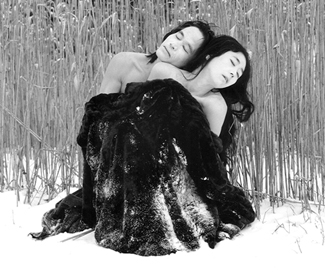arts@sfbg.com
DANCE The United States Bicentennial, 1976, was also the middle of what some have called the Golden Age of American dance. Balanchine premiered Union Jack; Twyla Tharp turned ballet inside out with Baryshnikov in Push Comes to Shove; the Philip Glass-Robert Wilson-Lucinda Childs team had a monster hit with Einstein at the Beach (side note: Berkeley’s Cal Performances presents it in October); and the Merce Cunningham Dance Company was invited to the prestigious Avignon Festival for the first time.
At the Performing Garage, Manhattan’s dumpiest theater in not-yet-chic SoHo, two small, skinny, New York-based Japanese dancers — just back from Europe where they had soaked up what had remained of German Expressionism — premiered White Dance. They were Eiko and Koma. An excerpt from that early work will close their two-week residency at Yerba Buena Center for the Arts.
Eiko and Koma have changed dance the way few others have. They have redefined theatrical time and space, the body as an instrument, and concepts surrounding expressivity. With but a few exceptions, they have always created on themselves. One man, one woman — and the universe. Most remarkably, to this day they have no imitators. They are truly unique.
While they sometimes paint their bodies white and have learned from Butoh’s glacial sense of time — they were early, though for a short time only, students of Butoh founder Tatsumi Hijikata — their works have none of that art’s existential emptiness; neither its twist of anarchy and despair, nor its dark sense of humor. Eiko and Koma see themselves connected to something larger than ourselves. They call their pieces Tree, Breath, River, Echo, Land, Wind. Their latest work is Naked.
David Harrington, founder and first violinist of the Kronos Quartet, has known the duo for close to 20 years. Speaking from Toronto, where the musicians are on tour, he describes what these dancers do as “traveling through time, memory, and experience to find something that, perhaps, we didn’t know existed.”
Watching Naked, he says, “I totally understood nakedness and the reason for it. There was something so honest and revealing and personal, and it was dangerous as well. They are about my age, and there they were offering themselves to the universe in such an incredible way. My feeling at the moment was that all of us, no matter how old we get, were very, very young. The flesh takes on different forms of age, but still we almost become like babies. Age no long had any meaning because I thought they were communicating with the universe in this incredible way.”
Drawing on this experience encouraged Harrington to commit to the four-hour Fragile, a collaborative installation between Kronos and Eiko and Koma this coming weekend. Harrington remembers that the duo had told him of three events that had formed their creativity and outlook: the dropping of the atomic bomb that happened before their birth; the 1967-68 student riots in Tokyo in which they participated, and the recent tsunami. So he composed Fragile‘s score from documentary material and music from Kronos’ repertoire plus — a first for Kronos — by Richard Wagner.
The following weekend’s Regeneration will offer Raven, Night Tide, and an excerpt from White Dance. At pre-performance event March 24, kindred spirit Shinichi Iova-Koga of inkBoat will interview the two artists about their working method and other topics.
“What I remember about their work is the images,” Iova-Koga explains. (He has seen their three local performances.) “Besides any particular beauty, these images were long enough to burn themselves into my memory. Years and years later I can still recall them. Part of Eiko and Koma’s power comes from all of this time of making pieces on a one-on-one relationship: two bodies relating to each other.” *
EIKO AND KOMA
Fragile with Kronos Quartet
Thurs/15-Fri/16, 5-9 p.m.; Sat/17, 3-7 p.m., $10
Regeneration: Raven (2010), Night Tide (1984), and White Dance (1976)
March 22-24, 8 p.m., $25
Yerba Buena Center for the Arts
701 Mission, SF

